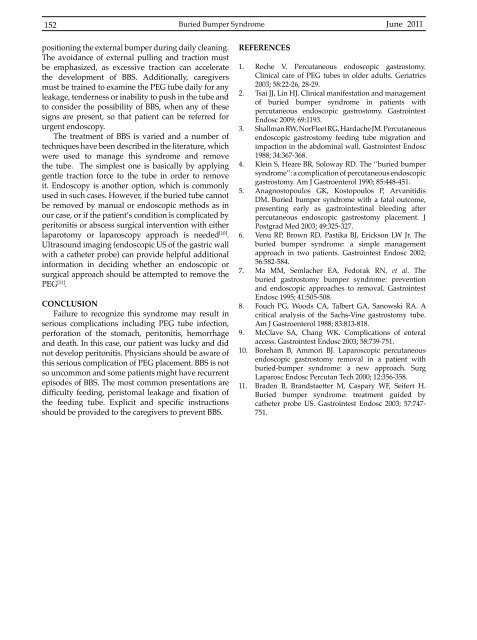Vol 43 # 2 June 2011 - Kma.org.kw
Vol 43 # 2 June 2011 - Kma.org.kw
Vol 43 # 2 June 2011 - Kma.org.kw
You also want an ePaper? Increase the reach of your titles
YUMPU automatically turns print PDFs into web optimized ePapers that Google loves.
152<br />
Buried Bumper Syndrome<br />
<strong>June</strong> <strong>2011</strong><br />
positioning the external bumper during daily cleaning.<br />
The avoidance of external pulling and traction must<br />
be emphasized, as excessive traction can accelerate<br />
the development of BBS. Additionally, caregivers<br />
must be trained to examine the PEG tube daily for any<br />
leakage, tenderness or inability to push in the tube and<br />
to consider the possibility of BBS, when any of these<br />
signs are present, so that patient can be referred for<br />
urgent endoscopy.<br />
The treatment of BBS is varied and a number of<br />
techniques have been described in the literature, which<br />
were used to manage this syndrome and remove<br />
the tube. The simplest one is basically by applying<br />
gentle traction force to the tube in order to remove<br />
it. Endoscopy is another option, which is commonly<br />
used in such cases. However, if the buried tube cannot<br />
be removed by manual or endoscopic methods as in<br />
our case, or if the patient’s condition is complicated by<br />
peritonitis or abscess surgical intervention with either<br />
laparotomy or laparoscopy approach is needed [10] .<br />
Ultrasound imaging (endoscopic US of the gastric wall<br />
with a catheter probe) can provide helpful additional<br />
information in deciding whether an endoscopic or<br />
surgical approach should be attempted to remove the<br />
PEG [11] .<br />
CONCLUSION<br />
Failure to recognize this syndrome may result in<br />
serious complications including PEG tube infection,<br />
perforation of the stomach, peritonitis, hemorrhage<br />
and death. In this case, our patient was lucky and did<br />
not develop peritonitis. Physicians should be aware of<br />
this serious complication of PEG placement. BBS is not<br />
so uncommon and some patients might have recurrent<br />
episodes of BBS. The most common presentations are<br />
difficulty feeding, peristomal leakage and fixation of<br />
the feeding tube. Explicit and specific instructions<br />
should be provided to the caregivers to prevent BBS.<br />
REFERENCES<br />
1. Roche V. Percutaneous endoscopic gastrostomy.<br />
Clinical care of PEG tubes in older adults. Geriatrics<br />
2003; 58:22-26, 28-29.<br />
2. Tsai JJ, Lin HJ. Clinical manifestation and management<br />
of buried bumper syndrome in patients with<br />
percutaneous endoscopic gastrostomy. Gastrointest<br />
Endosc 2009; 69:1193.<br />
3. Shallman RW, NorFleet RG, Hardache JM. Percutaneous<br />
endoscopic gastrostomy feeding tube migration and<br />
impaction in the abdominal wall. Gastrointest Endosc<br />
1988; 34:367-368.<br />
4. Klein S, Heare BR, Soloway RD. The ‘’buried bumper<br />
syndrome’’: a complication of percutaneous endoscopic<br />
gastrostomy. Am J Gastroenterol 1990; 85:448-451.<br />
5. Anagnostopoulos GK, Kostopoulos P, Arvanitidis<br />
DM. Buried bumper syndrome with a fatal outcome,<br />
presenting early as gastrointestinal bleeding after<br />
percutaneous endoscopic gastrostomy placement. J<br />
Postgrad Med 2003; 49:325-327.<br />
6. Venu RP, Brown RD, Pastika BJ, Erickson LW Jr. The<br />
buried bumper syndrome: a simple management<br />
approach in two patients. Gastrointest Endosc 2002;<br />
56:582-584.<br />
7. Ma MM, Semlacher EA, Fedorak RN, et al. The<br />
buried gastrostomy bumper syndrome: prevention<br />
and endoscopic approaches to removal. Gastrointest<br />
Endosc 1995; 41:505-508.<br />
8. Fouch PG, Woods CA, Talbert GA, Sanowski RA. A<br />
critical analysis of the Sachs-Vine gastrostomy tube.<br />
Am J Gastroenterol 1988; 83:813-818.<br />
9. McClave SA, Chang WK. Complications of enteral<br />
access. Gastrointest Endosc 2003; 58:739-751.<br />
10. Boreham B, Ammori BJ. Laparoscopic percutaneous<br />
endoscopic gastrostomy removal in a patient with<br />
buried-bumper syndrome: a new approach. Surg<br />
Laparosc Endosc Percutan Tech 2000; 12:356-358.<br />
11. Braden B, Brandstaetter M, Caspary WF, Seifert H.<br />
Buried bumper syndrome: treatment guided by<br />
catheter probe US. Gastrointest Endosc 2003; 57:747-<br />
751.
















